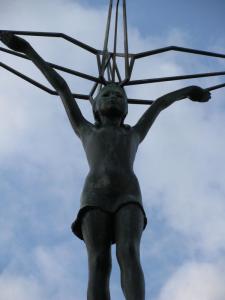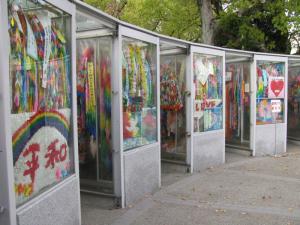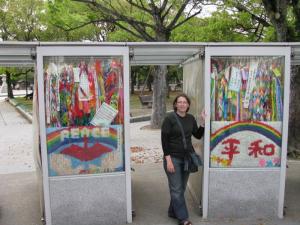Thousand Paper Cranes
I think it is strange that I spent so many years in school as a young child and, yet, I have few vivid memories from those experiences. Somehow all those years have contributed to who I am without me really understanding which experiences had the most impact, instead they seem to have all mixed and muddled together with the end result being the person I am today.
I do have a few specific memories, however, and one of them sprung out of the dusty depths of my brain during our trip to Hiroshima.
I remember my 5th grade teacher quite vividly. Her name was Mrs. Greenberger (at first we really got a chuckle out of her name) and she was one of the most charismatic and engaging teachers I ever had. Somehow she just seemed to make everything come to life. One of the units of study we had that year was WWII. Instead of studying it by reading textbooks and memorizing facts and dates, she had us study the war by reading literature, both non-fiction and historical fiction, about it. One of the stories we read was Sadako and the Thousand Paper Cranes.
Sadako was only two years old when the bomb was dropped and shortly thereafter she was diagnosed with leukemia. Ten years after the bomb dropped she was hospitalized and told that she had less than a year to live. Knowing that folding 1,000 paper cranes was said to bring good luck, she started to fold and she kept on folding. There is some disagreement over whether she actually finished her cranes, the book “Sadako and the Thousand Paper Cranes” said she did not, while the exhibit at the Peace Museum said that she did. Regardless of whether or not she finished them, the crane became a symbol of peace and determination as a result of her effort.
When we read the story in 5th grade, we also learned to fold cranes ourselves. We started by folding them with giant sheets of newsprint, which were easier to maneuver with the complex directions. And once we mastered that we moved on to the smaller sheets. And finally we got to use the special paper that Mrs. Greenberger had purchased. Our class never finished 1,000 but we did make quite a few. And I still remember, to this day, how to fold a crane.
When we visited Hiroshima I was surprised to see how many people and groups have reached their goal of 1,000. Near the dome there is an area where people can donate their cranes and sign a register. The millions of cranes are there, on display, for visitors to see and admire.
All those cranes symbolize the wish and hope of people around the world for long-lasting peace and a world free from the nuclear weapons that caused Sadako’s illness in the first place.
As soon as I saw the monument I was reminded of my 5th grade class and I was surprised at how many of Mrs. Greenberger’s lessons came flooding back to me. It is amazing that, after all these years, I can still find those memories when I am given something that triggers them. They are all in there somewhere, usually they are just hiding.




I’ve never read the story of Sadako, but I’ve heard the legend, and I was moved to tears when I was reading through the display about her in the Hiroshima peace museum. It’s a very powerful message.
Before I saw that exhibit I didn’t really understand what was so bad about the Atomic bombs, but which I mean, what was any worse about them than the daily conventional bombing raids the Allies were making over Japan and Germany during the last few years of the war. From what I understand, the USA killed far more people firebombing Tokyo than it did with atomic bombs in Hiroshima and Nagasaki. I’m not saying that the intentional targeting of cities and other civilian targets by allied bombers weren’t atrocities. They were. In my mind the bombing of civilian targets was one of the most shameful and wasteful things done during World War II. But I didn’t understand why using the atomic bomb was particularly atrocious.
Now I do.